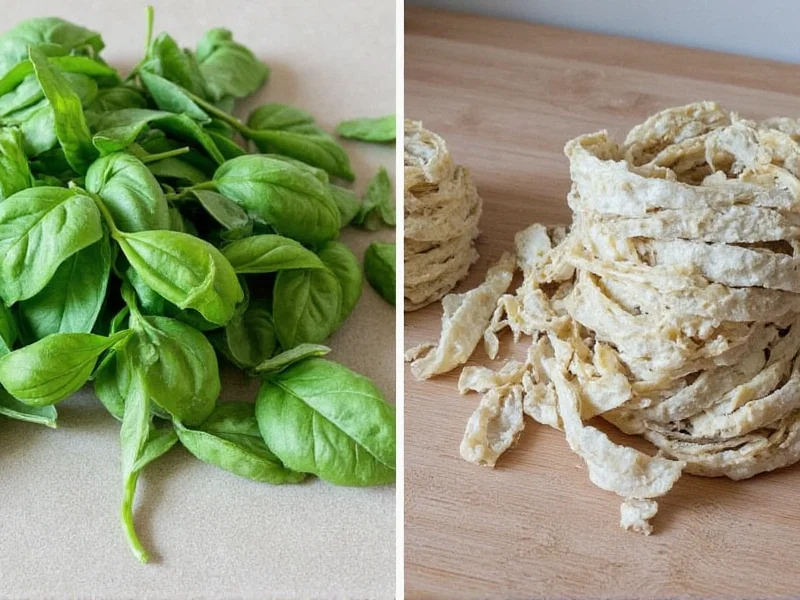When converting fresh herbs to dried in your cooking, understanding the proper measurement ratio is essential for maintaining recipe balance and flavor. The standard culinary conversion ratio between fresh and dried herbs is 3:1—meaning you need one-third the amount of dried herbs compared to fresh because the drying process concentrates the essential oils and flavors.
For 1/2 cup fresh basil specifically, the precise conversion to dried basil is 2 tablespoons plus 2 teaspoons. This calculation comes from basic measurement conversions: since 1 cup equals 16 tablespoons, half a cup equals 8 tablespoons of fresh basil. Applying the 3:1 ratio (8 ÷ 3 = 2.67), you get approximately 2 and two-thirds tablespoons of dried basil, which translates to 2 tablespoons plus 2 teaspoons.
| Measurement of Fresh Basil | Equivalent Dried Basil |
|---|---|
| 1 cup | 5 tablespoons + 1 teaspoon |
| 3/4 cup | 4 tablespoons |
| 1/2 cup | 2 tablespoons + 2 teaspoons |
| 1/3 cup | 1 tablespoon + 2 teaspoons |
| 1/4 cup | 1 tablespoon + 1 teaspoon |
| 2 tablespoons | 2 teaspoons |
| 1 tablespoon | 1 teaspoon |
The concentration difference between fresh and dried basil exists because fresh herbs contain significant moisture—typically 80-90% water content—that evaporates during the drying process. This water loss intensifies the herb's flavor compounds, making dried basil more potent by volume. When substituting dried basil for fresh in recipes, particularly in dishes with shorter cooking times like salads or garnishes, you'll need to adjust quantities carefully to avoid overpowering other flavors.
For optimal results when using dried basil instead of fresh, consider these practical tips:
- Add dried herbs earlier in the cooking process to allow time for rehydration and flavor release
- Crumble dried basil between your fingers before adding to release essential oils
- For cold dishes like salads or dressings, consider using fresh basil as dried won't rehydrate properly
- Store dried basil in an airtight container away from light and heat to preserve potency
- Check dried basil's freshness by rubbing and smelling—it should have a strong, sweet aroma
Many home cooks make the mistake of using equal measurements when substituting dried for fresh basil, resulting in dishes that taste overly herbal or bitter. Remember that dried basil has a slightly different flavor profile—it tends to be more muted and earthy compared to the bright, sweet notes of fresh basil. In tomato-based dishes like pasta sauces, the difference is less pronounced, but in delicate dishes like pesto or caprese salad, fresh basil provides an irreplaceable flavor dimension.
When converting measurements for other herbs, note that the 3:1 ratio applies generally but with some variations. Delicate herbs like parsley and cilantro follow the standard ratio closely, while more robust herbs like rosemary and thyme may require a 4:1 ratio due to their higher oil concentration. Always adjust to taste after making the initial conversion, as herb potency can vary based on growing conditions, drying methods, and storage duration.
For recipe developers and serious home cooks, understanding these herb conversion principles prevents common seasoning errors. Whether you're converting 1/2 cup fresh basil to dried measurements for a large batch recipe or making smaller adjustments, applying the correct ratio ensures consistent results. Professional chefs often keep conversion charts handy in their kitchens, recognizing that precise herb measurements significantly impact final dish quality.
Can I use dried basil instead of fresh in pesto?
While possible, dried basil doesn't work well in traditional pesto. The texture and flavor profile differ significantly—fresh basil provides the bright, grassy notes essential to authentic pesto. If you must substitute, use one-third the amount of dried basil and add a squeeze of lemon to mimic some freshness, but expect a noticeably different result.
How long does dried basil retain its flavor?
Properly stored dried basil maintains good flavor for 1-2 years. Store in an airtight container away from light, heat, and moisture. After this period, it won't spoil but will gradually lose potency, requiring you to use more to achieve the same flavor impact.
Why does the fresh to dried herb conversion ratio vary by herb?
Different herbs have varying moisture content and essential oil concentrations. Delicate leafy herbs like basil and parsley follow the standard 3:1 ratio, while woody herbs like rosemary and thyme often require a 4:1 ratio because they contain higher concentrations of flavor compounds that intensify more during drying.
What's the best way to measure dried herbs accurately?
Use proper measuring spoons rather than estimating. For quantities like 2 tablespoons plus 2 teaspoons (the conversion for 1/2 cup fresh basil), measure each component separately. Level off each spoon with a straight edge for precision, as packed versus loose measurements can vary significantly in potency.











 浙公网安备
33010002000092号
浙公网安备
33010002000092号 浙B2-20120091-4
浙B2-20120091-4